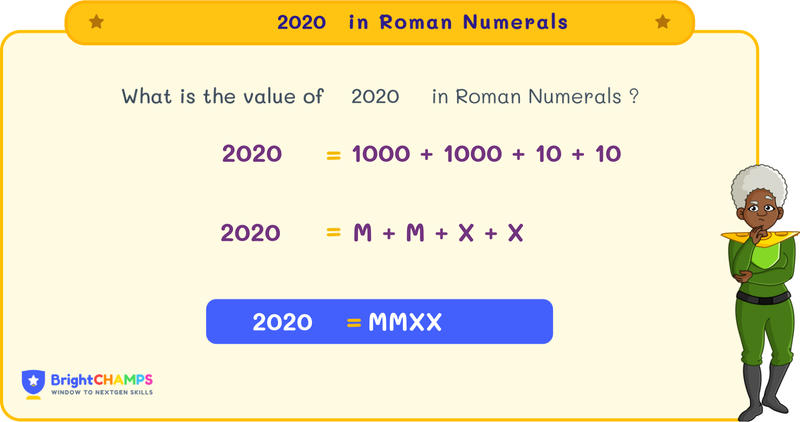
 155 Learners
155 LearnersLast updated on May 26th, 2025

2020 in Roman Numerals

Roman numerals are a way of expressing numbers using symbols. The symbols I, V, X, L, C, D, and M are used. Roman numerals are often found in royal titles, book names, sequences, and more. In this article, we will explore Roman numerals, their rules, and examples.
What is 2020 in Roman Numerals?
You might have come across royal titles like Louis XIV or Elizabeth II and wondered about the Roman numerals. These numerals have a long history, with ancient Romans using them for counting as life became more complex.
The symbols I (1), V (5), X (10), L (50), C (100), D (500), and M (1000) are used for counting. For 2020, Roman numerals are written as MMXX, where M stands for 1000 and X stands for 10.
Let's delve deeper into Roman numerals and how to write them.

Struggling with Math?
Get 1:1 Coaching to Boost Grades Fast !

Basic Rules for 2020 in Roman Numerals
Writing numbers in Roman numerals follows certain basic rules. Let's discuss some key rules to remember:
Rule 1: Addition Method
When a smaller numeral follows a larger numeral, their values are added. For example, MMXX → M + M + X + X → 1000 + 1000 + 10 + 10 = 2020
Rule 2: Repetition Method
Certain Roman numerals can be repeated up to three times. For instance, XXX → 30.
Rule 3: Subtraction Method
When a smaller numeral precedes a larger numeral, the smaller is subtracted from the larger. For example, IX → X - I → 10 - 1 = 9
Rule 4: Limitation Rule
Symbols cannot be repeated more than three times, and some symbols like V, L, and D cannot be repeated. For example, 40 is XL, not XXXX.
How to Write 2020 in Roman Numerals
Let's learn how to write 2020 in Roman numerals. There are two methods: By Expansion Method By Grouping Method
2020 in Roman Numerals by Expansion Method
Using the expansion method, numbers are broken down based on place value. Here's how to write 2020 in Roman numerals:
Step 1: Break down the number by place value: 2000 + 20
Step 2: Convert to Roman numerals:
2000 in Roman numerals is MM
20 in Roman numerals is XX
Step 3: Combine them: MM (2000) + XX (20) = MMXX
2020 in Roman Numerals by Grouping Method
For large numbers, grouping helps in writing Roman numerals.
For 2020: Group: 2000 + 20
2000 in Roman numerals is MM
20 in Roman numerals is XX
Thus, 2020 is written as MMXX in Roman numerals.

Common Mistakes and How to Avoid Them in 2020 Roman Numerals
Mistakes in writing Roman numerals are common. Here are some errors and tips to avoid them.
Level Up with a Math Certification!
2X Faster Learning (Grades 1-12)


2020 in Roman Numerals Examples

Problem 1
A historian discovers that MMXX ancient scrolls are stored in a library and plans to distribute them equally among XL librarians. How many scrolls will each librarian receive?

Each librarian will receive LI scrolls.
Explanation
To determine how many scrolls each librarian receives, divide the total number of scrolls by the number of librarians.
MMXX = 2020
XL = 40
2020 / 40 = 50.5
Since scrolls cannot be divided, each librarian receives LI (51) whole scrolls, and some scrolls remain.

Problem 2
A time capsule is set to be opened after MMXX years, which started from the year MD. In which year will it be opened?

The time capsule will be opened in the year MMMXX.
Explanation
To find the opening year, add the starting year to the duration.
MD = 1500
MMXX = 2020
1500 + 2020 = 3520
3520 in Roman Numerals is written as MMMXX.

Problem 3
An artist is creating a mural that represents the year MMXX using Roman numerals. She decides to paint MCMXCIX and XXI next to each other. What does this represent?

The mural represents the years MCMXCIX and XXI as MMXX.
Explanation
Add the two Roman numerals to find the year they represent together:
MCMXCIX = 1999
XXI = 21
1999 + 21 = 2020
Thus, MCMXCIX and XXI together represent MMXX.

Problem 4
A mathematician wants to show that the sum of M and M, when added to XX, equals MMXX. Verify this statement.

The statement is correct; the sum is MMXX.
Explanation
First, convert the Roman numerals to numbers and perform the addition:
M = 1000
M = 1000
XX = 20
1000 + 1000 + 20 = 2020
2020 in Roman Numerals is written as MMXX.

Problem 5
A puzzle involves rearranging the numerals in MMXX to form two separate numbers that sum to MMXX. Find one such pair.

One such pair is MD (1500) and DXX (520).
Explanation
To find a pair, convert MMXX to its numerical value, 2020, and find two numbers that sum to it:
MD = 1500
DXX = 520
1500 + 520 = 2020
Hence, MD and DXX form a pair that sums to MMXX.

Turn your child into a math star!
#1 Math Hack Schools Won't Teach!


FAQs on 2020 in Roman Numerals
1.What is 19 in Roman numerals?
2.How to write 2020 in Roman numerals?
3.What is 2023 in Roman Numerals?
4.Is MMXX a prime number?
5.What are the multiples of 2020?
6.How can children in Bahrain use numbers in everyday life to understand 2020 in Roman Numerals?
7.What are some fun ways kids in Bahrain can practice 2020 in Roman Numerals with numbers?
8.What role do numbers and 2020 in Roman Numerals play in helping children in Bahrain develop problem-solving skills?
9.How can families in Bahrain create number-rich environments to improve 2020 in Roman Numerals skills?
Struggling with Math?
Get 1:1 Coaching to Boost Grades Fast !

Important Glossaries for 2020 in Roman Numerals
- Addition Rule: When a larger numeral is followed by a smaller, their values are added. For example, MMXX = M + M + X + X = 2020.
- Grouping Method: Numbers are grouped based on place value, then each group is converted to Roman numerals. Example: 2020 = 2000 + 20 = MMXX.
- Repetition Rule: Roman numerals like I, X, C, and M can be repeated up to three times. Example: XXX = 30.
- Subtraction Rule: When a smaller numeral precedes a larger one, the smaller is subtracted. Example: IV = 4.
- Limitation Rule: Symbols cannot be repeated more than three times, and V, L, and D are not repeated. Example: 40 is XL, not XXXX.
Explore More numbers
![Important Math Links Icon]() Previous to 2020 in Roman Numerals
Previous to 2020 in Roman Numerals
About BrightChamps in Bahrain


Hiralee Lalitkumar Makwana
About the Author
Hiralee Lalitkumar Makwana has almost two years of teaching experience. She is a number ninja as she loves numbers. Her interest in numbers can be seen in the way she cracks math puzzles and hidden patterns.
Fun Fact
: She loves to read number jokes and games.




